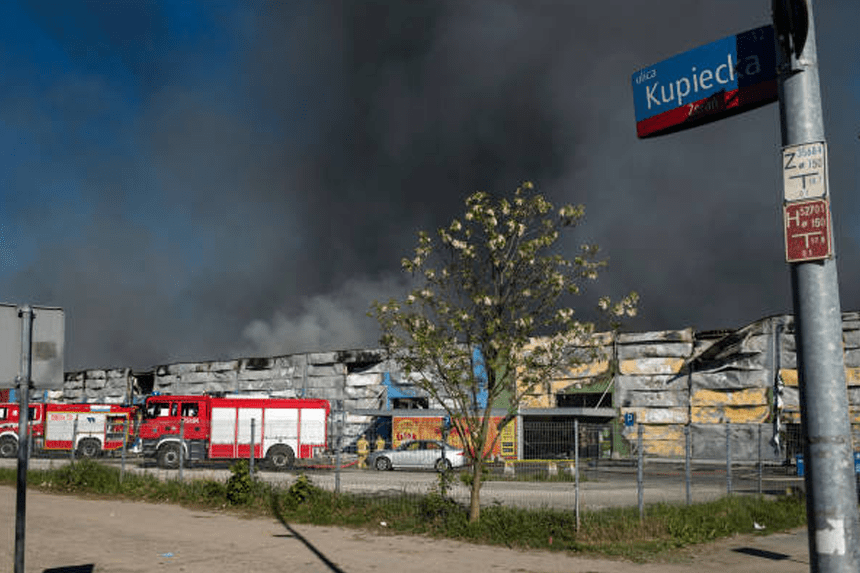A major fire has destroyed the Marywilska shopping centre in Warsaw, Poland, in May 2024. For the Vietnamese community, many of whom owned stores in the center, the fire destroyed over 1,400 small enterprises was especially catastrophic. Alleging that the fire was part of a larger hybrid warfare tactic, Prime Minister Donald Tusk of Poland accused Russian intelligence services of planning it. Tusk claims that this deed was a clandestine attack meant to destabilize Poland and other European countries without direct military involvement. The repercussions of the fire on the nearby population were emotional as well as financial; many businesses and individuals suffered great personal and financial losses.
Define hybrid warfare exactly.
A combination of traditional and non-traditional strategies used to challenge the political, economic, and social stability of an opponent is referred to as hybrid warfare. Unlike conventional warfare, which entails direct military engagement, hybrid warfare uses a range of non-traditional techniques, including cyberattacks, disinformation operations, economic sabotage, and, as shown by the Marywilska fire, acts of terrorism or sabotage. The most obvious feature of hybrid warfare is its deniability: an aggressor can carry out these acts without direct attribution, therefore making it challenging for the targeted country to react successfully.
Russia has been regularly charged with employing hybrid warfare strategies in Europe. These covert activities let Russia forward its aims without starting a full-scale armed fight. Regarding the Marywilska fire, Poland claims that Russian intelligence agencies planned the attack to destabilize the country and undermine its support for Ukraine, amid the continuous confrontation with Russia.
How did the Marywilska Fire affect local businesses and employees?
For small shops, many of which were managed by Vietnamese community members, the Marywilska shopping centre was a hive. From electronics to food and clothes, the stores at the shopping center offered a broad spectrum of goods, therefore supporting Warsaw’s dynamic multicultural economy. But when the fire started, it destroyed not only the retail centre’s infrastructure but also numerous shop owners’ means of income.
Fears of theft at home had many of these shop owners store big amounts of cash and crucial paperwork at their stores. The fire damaged the shopping mall, therefore depriving them of both vital company records and hard-earned cash. Both practically and emotionally, these dealers suffered greatly.
The owners of the shopping center responded swiftly to the damage by establishing a makeshift center where 400 traders could start business once more. While many company owners were able to recover, the long-term consequences of the fire persisted and many questioned whether the claimed source of the fire—alleged to be part of a bigger hybrid warfare campaign—was a threat they could not ignore. Read another article on Investigating Hybrid Warfare
The Growing Danger of European Hybrid Warfare
Since Russia’s full-scale invasion of Ukraine in 2022, European countries have been increasingly worried about hybrid war threats. More than only physical strikes, hybrid warfare involves. It also covers acts meant to undermine the political and social cohesiveness of a target nation, usually using covert operations devoid of immediate military reaction. There have been other instances of such an attack besides the Marywilska shopping center fire. Numerous European countries have witnessed similar acts of sabotage carried out in line with Russia’s larger attempts to destabilize the area.
An arson attack against an Ikea branch in Vilnius, Lithuania, in 2023 is one noteworthy event that happened before the Marywilska fire. Like the fire in Warsaw, the Ikea fire was considered part of Russia’s secret plan of hybrid warfare, meant to compromise Lithuania’s economic stability. Both times, the attacks were aimed at the small-business sector and civilian infrastructure, two areas typically more susceptible to such clandestine operations. These kinds of strikes are below the level of traditional warfare, hence nations find it more difficult to engage in direct military operations or react in a way that would raise hostilities.
These events also raise issues regarding national defense strategies against similar assaults. Given the difficulty in attributing these covert activities, nations may find it difficult to react in a way that tackles the more general threat of hybrid warfare. The Marywilska shopping center fire highlights for Poland the need for better security and international intelligence-sharing among European countries to offset such dangers.
How Should Nations Respond to Hybrid War?
National security suffers much from the emergence of hybrid warfare. Unlike traditional military threats, hybrid warfare is sometimes hard to spot and assign, which complicates attempts at reaction. Countries under hybrid warfare campaigns have to so increase their capacity to identify and counteract these concealed hazards.
By strengthening its cybersecurity policies and collaborating with foreign partners to exchange intelligence, Poland, for example, has sought to increase its resistance against hybrid attacks. More work has to be done, though, to create a thorough defense plan combining conventional and non-traditional kinds of attack. This covers not only protecting vital infrastructure but also fostering political and financial resilience against such clandestine dangers.
Improving nations’ capacity to identify and thwart cyberattacks is one area where they most definitely need work. Cyberattacks have taken front stage in hybrid warfare as more nations rely more on digital networks for their governance and economy. Nations have to make investments in cybersecurity to guard the public and private sectors against cyberattacks meant to cause havoc with their systems.
Furthermore, vital is international cooperation. Countries must cooperate to cover the whole range of threats since hybrid warfare sometimes consists of several kinds of attack, including cyberattacks, disinformation, and physical disruption. Building a defense against hybrid threats depends on intelligent sharing and coordinated reactions. Poland has already shown the value of working with other European nations, particularly with Lithuania, in looking at the fires and other connected events. As the threat of hybrid warfare rises, such alliances will become ever more crucial.
Ultimately: The Prospect of Hybrid Warfare and Its Effects on Europe
The accusations against Russia for their involvement in the Marywilska shopping center fire draw attention to the growing threat hybrid warfare presents for Europe. National security is seriously threatened by these covert activities meant to undermine economies and society without direct military intervention. Though the fire in Warsaw is a sad occurrence in and of itself, it also reminds us of the more general threats hybrid strategies create.
Countries have to be ready to react creatively as hybrid warfare events grow in Europe. Protecting national security will depend on building a robust defense system that addresses both conventional and non-traditional threats. Nations must cooperate, exchange intelligence, and create plans that can neutralize the whole range of hybrid threats in the face of these mounting hazards. Europe can properly resist the changing character of warfare only by working together and being ready.
The Mariupol fire and related strikes show how hybrid warfare functions in the modern world. These strategies change; thus, the reactions to them also change. The capacity of Europe to overcome these obstacles will define its future resilience against this new, covert type of conflict.








